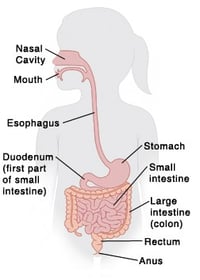Gastric Emptying Study
Your child’s scan is scheduled for (date) ___________ on (time) _______________ in the Imaging (Radiology) Department at Children’s Wisconsin.
Please stop at a Welcome desk to get a badge and directions to Imaging.
What is a gastric emptying study?
The part of the body that carries food from the mouth to the stomach is called the food tube, or esophagus. When food in the stomach goes back up into the food tube, it is called reflux. A gastric emptying scan helps the doctor look for gastroesophageal reflux.
This test may also be used to see:
- Why there are problems with feeding.
- How fast the food leaves the stomach.
- If the food is moving back into the food tube and then into the lungs.
Special instructions
Your child can not have anything to eat or drink before the scan. Please use the guide below based on your child's age:
0 – 5 months old: No food, formula or breast milk 4 hours before the scan.
Nothing to eat or drink 4 hours before the scan.
6 months – and older: No food, formula or breast milk 6 hours before the scan.
Nothing to eat or drink 6 hours before the scan.
Please bring a prepared normal feeding to the scan. The food will be used in the scan.
Follow the guidelines below for your child's age:
Infants under 1 year old: A prepared bottle (formula, breast milk).
Children 1 year old and older: 12 ounce bottle of milk or juice.
If a solid or dual phase has been ordered, food and juice will be provided.
How the scan is done
Persons trained in doing the scan will help your child with the procedure and answer any questions you may have.
- For a liquid gastric empty, your child will be given milk or juice.
- For the dual phase or solid empty your child will be given scrambled eggs, toast and juice. Please tell us if your child has any allergies.
- The milk or juice needs to be given quickly. If your child can drink fast, they can use a cup. If not, a nurse may need to put a small flexible tube into your child’s nose for a couple of minutes to give the milk or juice. Other tubes such as a G-tube or GJ-tube can also be used. Older children may drink and eat on their own. A small amount of radioactive liquid will be added to the feeding. The liquid does not hurt your child and has no smell or taste. This radioactive liquid lets the technologist see where the feeding goes once in your child's body.
- During the scan, your child will lie on a table. There is a special camera under the table. It can see and take pictures of the radioactive liquid. It will take 90 minutes to four hours to take the pictures.
Your child may be uncomfortable if a feeding tube is used. Feel free to bring comfort items to use during the test such as stuffed toys, blankets, books and DVD.
After the scan
- If more pictures are needed, you and your child will return to the hospital room or the Imaging Waiting Room. The staff will inform you when pictures will be taken.
- If no more pictures are needed you and your child are done.
Results
A doctor who has special training in reading x-rays, called a radiologist, will look at the pictures after the scan is done. Your child's doctor will get the results of the scan within 24 hours. This doctor will share the results with you.



